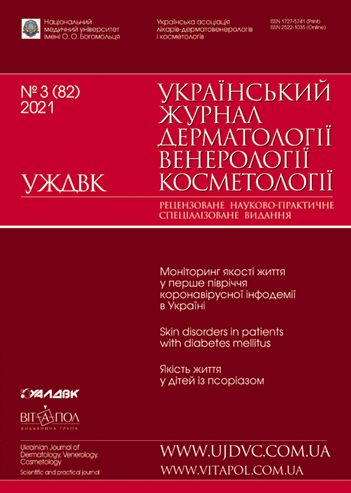Дослідження ефективності методів діагностики мікроспорії
DOI:
https://doi.org/10.30978/UJDVK2021-3-21Ключові слова:
мікроспорія; Microsporum canis; діагностикаАнотація
Мета роботи — визначити ефективність різних методів діагностики мікроспорії у дітей.
Матеріали та методи. Під спостереженням перебували 50 дітей віком від 2 до 16 років (24 хлопчики та 26 дівчаток). Залежно від клінічного перебігу, діагнозу та результатів досліджень усіх дітей було розділено на дві групи: до 1-ї групи включено 40 хворих на мікроспорію (19 — на мікроспорію гладенької шкіри, 13 — волосистої частини голови, 8 — волосистої частини голови і гладенької шкіри); до 2-ї групи — 10 дітей без мікроспорії. У всіх пацієнтів 1-ї групи клінічний діагноз підтверджено результатами досліджень методом полімеразної ланцюгової реакції (ПЛР), мікроскопічного, культурального та люмінесцентного (у променях лампи Вуда) досліджень. Матеріалом для досліджень слугували лусочки з гладенької шкіри та волосистої частини голови, а також волосся із волосистої частини голови пацієнтів. У 10 пацієнтів 2-ї групи клінічні вияви мікроспорії відсутні, результати досліджень — негативні.
Результати та обговорення. Обстеження дітей, хворих на мікроспорію, із застосуванням методу ПЛР мало 100 % позитивний результат. У всіх 40 пацієнтів виявлено ДНК Microsporum canis. Мікроскопічний метод дослідження виявився позитивним у 95 %. За даними бактеріологічного дослідження у 85 % визначено Microsporum canis, тоді як у 15 % дітей цей результат відсутній. Люмінесцентне світіння волосся в променях лампи Вуда в нашому дослідженні спостерігали у 87,5 % хворих, а у 12,5 % воно було відсутнє.
Висновки. За даними дослідження виявлено, що найбільш ефективним і точним є метод ПЛР. Це методика сучасної точної специфічної діагностики мікроспорії, що дає змогу провести ідентифікацію збудника Microsporum canis на рівні ДНК. Мікроскопічний, культуральний та люмінесцентний методи досліджень також можуть бути використані для діагностики цього захворювання.
Посилання
Antonova SB. Modern clinical and epidemiological features of the incidence of dermatomycosis in children. Optimization of diagnostic, medical and preventive technologies (Rus). Dissertacziya [Dissertation] (Rus). Ekaterinburg; 2019:118.
Antonova SB, Ufimczeva MA. The incidence of microsporia: epidemiological aspects, modern features of the course (Rus). Pediatriya. Zhurnal imeni GN Speranskogo [Pediatrics. Journal of the name of GN Speranskii] (Rus). 2016;95(2):142-146.
Lavrushko SI, Dudchenko MO, Pavlenko GP, Filatova VL. Modern complex treatment of microspores of smooth skin (Ukr). Ukrayinsky zhurnal dermatolohigii, venerolohigii, kosmetologii [Ukrainian journal of dermatology, venereology, cosmetology] (Ukr). 2018;2(69):16-22. doi:10.30978/UJDVK2018-2-16.
Lavrushko SI, Stepanenko VI. Optimization of modern complex treatment of microsporia in athletes taking into account the clinical course of dermatosis (Ukr). Ukrayinsky zhurnal dermatolohigii, venerolohigii, kosmetologii [Ukrainian journal of dermatology, venereology, cosmetology] (Ukr). 2020;3(78):29-38. doi:10.30978/UJDVK2020-3-29.
Lavrushko SI, Stepanenko VI. Modern diagnostics of microsporia (Ukr). Ukrayinsky zhurnal dermatolohigii, venerolohigii, kosmetologii [Ukrainian journal of dermatology, venereology, cosmetology] (Ukr). 2021;2(81):16-24. doi:10.30978/UJDVK2021-2-16.
Lavrushko SI, Stepanenko VI, Dudchenko MO, Pavlenko GP. Modern view on treatment of microsporia of children, taking into account the etiology, pathogenesis and features of clinical course of dermatosis (Ukr). Ukrayinsky zhurnal dermatolohigii, venerolohigii, kosmetologii [Ukrainian journal of dermatology, venereology, cosmetology] (Ukr). 2018;4(71):16-25. doi:10.30978/UJDVK2018-4-16.
Titova TN, Mavzyutov AR, Efimov GE. Comparative assessment of the information content of laboratory diagnostics methods of microsporia (Rus). Uspekhi mediczinskoj mikologii [Advances in medical mycology] (Rus). 2014;13:196-198.
Ufimczeva MA, Antonova SB, Bochkarev YuM, Nikolaeva KI, Sorokina KN, inventor. Method for differential diagnosis of microsporia of the scalp and alopecia areata in children (Rus). Patent RF [Patent RF] (Rus). N 2609204. 2017; November 20.
Kharisova AR, Khismatullina ZR. Difficulties in the diagnosis of infiltrative-suppurative microsporia. Clinical case (Rus). Problemy mediczinskoj mikologii [Problems of medical mycology] (Rus). 2018;20(4):31-33.
Aruna GL, Ramalingappa B. Development and evaluation of indirect enzyme linked immunosorbent assay for the serological diagnosis of Microsporum canis infection in humans. J Mycol Med. 2018 Jun;28(2):285-8. doi:10.1016/j.mycmed.2018.01.007.
Ciesielska A, Stączek P. Selection and validation of reference genes for qRT-PCR analysis of gene expression in Microsporum canis growing under different adhesion-inducing conditions. Sci Rep. 2018;8(1):1197.
Diongue K, Boye A, Bréchard L, Diallo MA, Dione H, Ndoye NW, Diallo M, Ranque S, Ndiaye D. Dermatophytic mycetoma of the scalp due to an atypical strain of Microsporum audouinii identified by MALDI-TOF MS and ITS sequencing. J Mycol Med. 2019Jun;29(2):185-8. doi:10.1016/j.mycmed.2019.03.001.
Hayette MP, Seidel L, Adjetey C, Darfouf R, Wéry M, Boreux R, Sacheli R, Melin P, Arrese J. Clinical evaluation of the DermaGenius® Nail real-time PCR assay for the detection of dermatophytes and Candida albicans in nails. Med Mycol. 2019Apr1;57(3):277-83. doi:10.1093/mmy/myy020.
Kobylak N, Bykowska B, Kurzyk E, Nowicki R, Brillowska-Dąbrowska A. PCR and real-time PCR approaches to the identification of Arthroderma otae species Microsporum canis and Microsporum audouinii/Microsporum ferrugineum. J Eur Acad Dermatol Venereol. 2016 Oct;30(10):1819-22. doi:10.1111/jdv.13681.
Ross IL, Weldhagen GF, Kidd SE. Detection and identification of dermatophyte fungi in clinical samples using a commercial multiplex tandem PCR assay. Pathology. 2020;52(4): 473-7. doi: 0.1016/j.pathol.2020.03.002.
Sato T, Asahina Y, Toshima S, Yaguchi T, Yamazaki K. Usefulness of Wood’s Lamp for the Diagnosis and Treatment Follow-up of Onychomycosis. Med Mycol J. 2020;61(2):17-21. doi:10.3314/mmj.20-00004.
Uhrlaß S, Wittig F, Koch D, Krüger C, Harder M, Gaajetaan G, Dingemans G, Nenoff P. Do the new molecular assays-microarray and realtime polymerase chain reaction-for dermatophyte detection keep what they promise? Hautarzt. 2019Aug;70(8):618-26. doi:10.1007/s00105-019-4447-z.
Witkowska E, Jagielski T, Kamińska A. Genus- and species-level identification of dermatophyte fungi by surface-enhanced Raman spectroscopy. Spectrochim Acta A Mol Biomol Spectrosc. 2018Mar5;192:285-90. doi:10.1016/j.saa.2017.11.008.
Ye F, Li M, Zhu S, Zhao Q, Zhong J. Diagnosis of dermatophytosis using single fungus endogenous fluorescence spectrometry. Biomed Opt Express. 2018May21;9(6):2733-42. doi:10.1364/BOE.9.002733.





